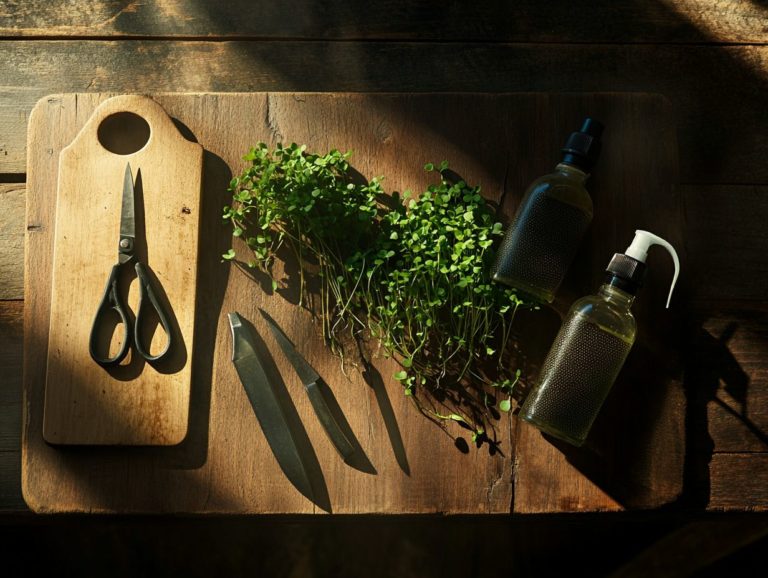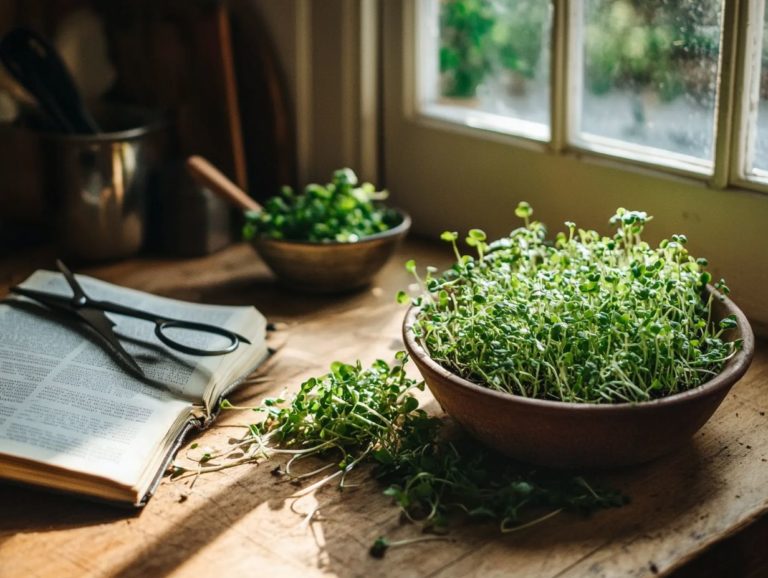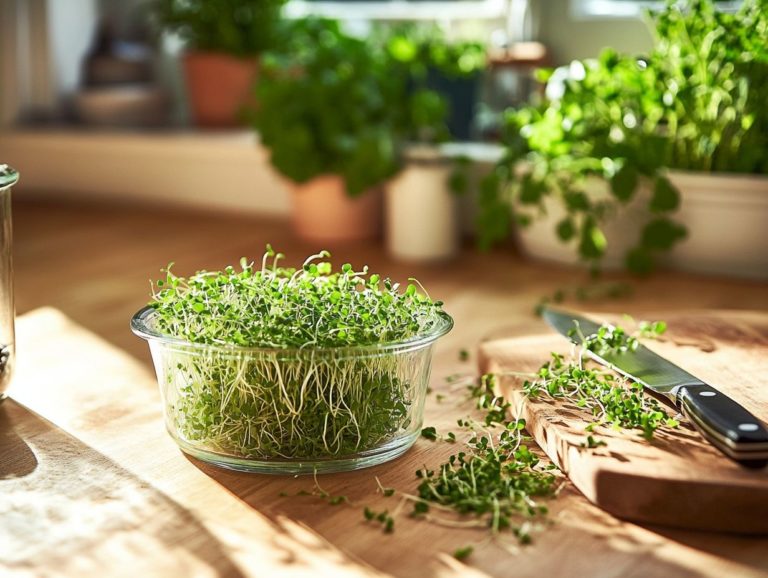How to Extend the Shelf Life of Microgreens
Proper storage is essential for extending the shelf life of microgreens, ensuring that these nutrient-packed powerhouses remain fresh and flavorful.
Numerous factors can influence their longevity, including environmental conditions and harvesting techniques.
Explore effective methods for extending their freshness, including optimal practices for storage and handling.
By grasping these essentials, you can elevate your culinary creations and minimize waste. Act quickly to savor every vibrant bite of microgreens!
Contents
- Key Takeaways:
- The Importance of Proper Storage for Microgreens
- Factors that Affect the Shelf Life of Microgreens
- Methods for Extending the Shelf Life of Microgreens
- Tips for Maintaining Freshness and Quality
- Frequently Asked Questions
- What are microgreens, such as broccoli, cabbage, kale, and radishes, and why is it important to extend their shelf life?
- How can I store microgreens to extend their shelf life?
- How long do microgreens typically last in the refrigerator?
- Can I freeze microgreens to extend their shelf life?
- Are there any tricks to extend the shelf life of microgreens?
- What are some signs that microgreens have gone bad?
Key Takeaways:
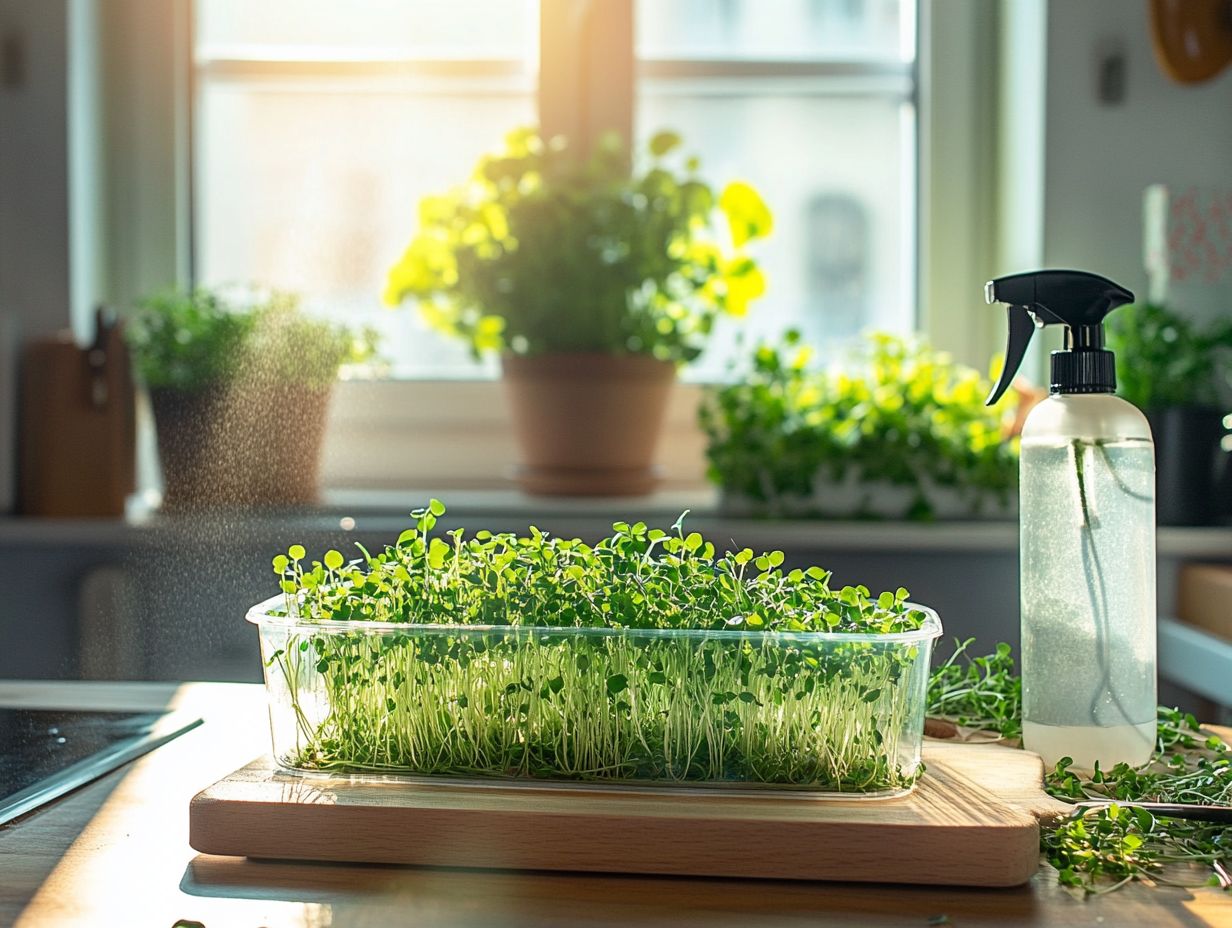
- Proper storage is crucial for extending the shelf life of microgreens.
- Environmental factors and harvesting techniques directly impact microgreens’ freshness.
- Use proper storage techniques to maintain freshness and avoid common mistakes.
The Importance of Proper Storage for Microgreens
Proper storage of microgreens is vital for extending their shelf life and maintaining their freshness. This directly influences both their nutritional value and overall quality.
Several factors play a role in how effectively you can preserve microgreens, including environmental conditions like temperature and humidity, as well as storage methods that can either enhance or diminish their longevity.
Understanding these principles is essential for anyone aiming to store microgreens effectively and enjoy their health benefits for an extended period.
Why Shelf Life Matters
Understanding the shelf life of microgreens is crucial for you, whether you’re a consumer or a grower. It directly affects how long you can enjoy these nutrient-packed plants before they start to lose their freshness and nutritional value.
The differing shelf lives of microgreens, like broccoli and kale, play a significant role in your purchasing decisions. For example, broccoli microgreens can stay fresh for up to a week when stored properly, while kale usually lasts around five days. To maximize freshness, it’s essential to understand how to store different microgreen varieties. This variation can impact your experience, especially for meal planning and minimizing waste.
To keep these delicate greens at their best, store them in a cool environment, ideally wrapped in a damp paper towel and placed in an airtight container.
Be mindful of your consumption use the older microgreens first to help reduce waste and enhance your enjoyment of these vibrant ingredients.
Factors that Affect the Shelf Life of Microgreens
Several key factors play a crucial role in determining the shelf life of microgreens. Environmental conditions, harvesting techniques, and moisture levels all influence how long these vibrant greens can retain their freshness and quality post-harvest.
Understanding these elements is essential for maximizing the longevity of your microgreens.
Environmental Factors
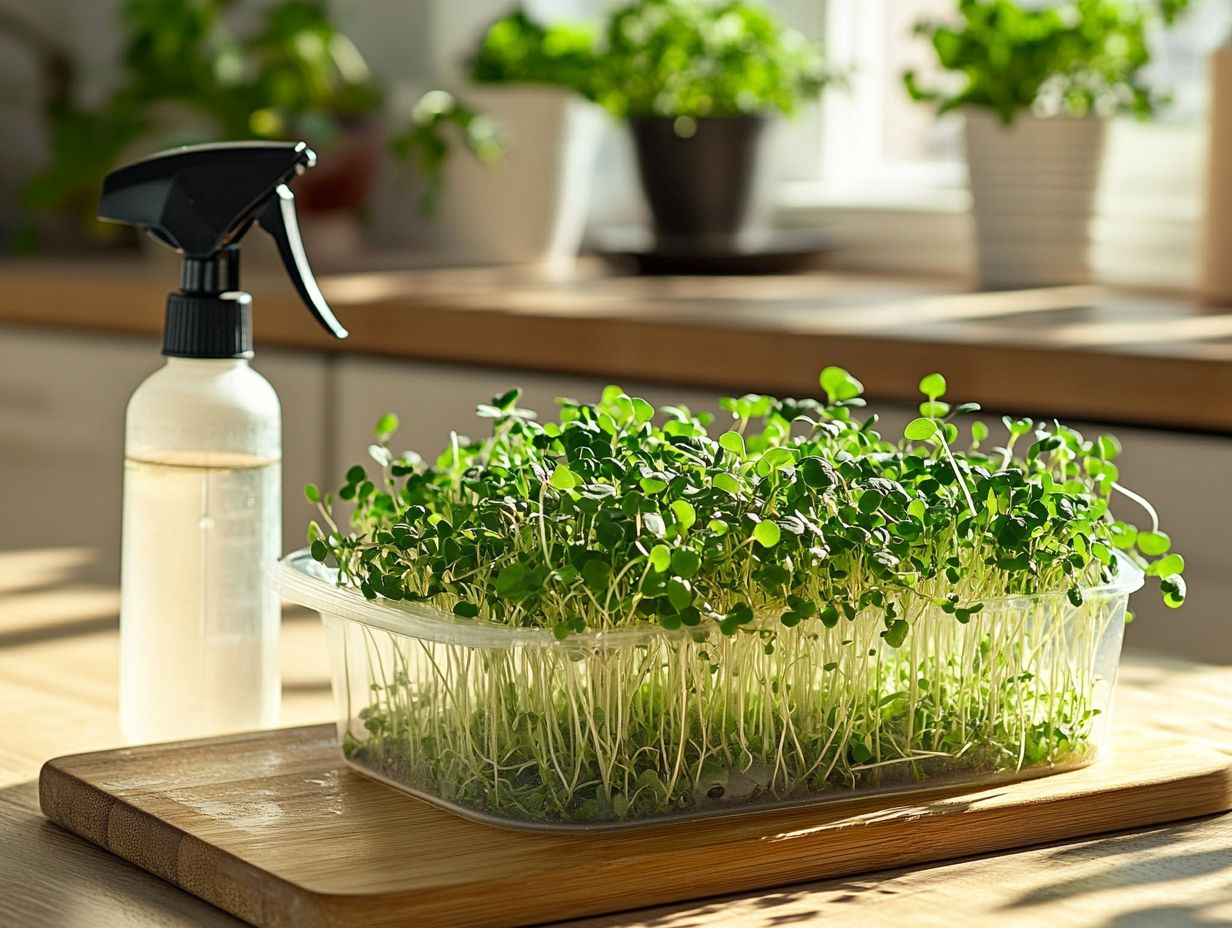
Environmental factors are pivotal in determining the shelf life of microgreens. Elements such as air circulation, moisture balance, and the presence of certain fruits that produce gases that can speed up decay significantly impact their freshness.
By properly managing these conditions, you can ensure that your microgreens remain vibrant and nutrient-rich for an extended period. For optimal air circulation, consider storing them in breathable containers or leaving them partially uncovered in the refrigerator.
It s crucial to maintain balanced moisture levels; excessive humidity can lead to mold, while insufficient moisture can cause wilting.
Be cautious of ethylene-emitting items, such as bananas or avocados, as their gases can accelerate the decay of stored produce. To preserve quality, keep microgreens away from these items, and use separate drawers or crisper bins in your refrigerator designed for vegetables.
Harvesting and Handling Techniques
The techniques you use during the harvesting and handling of microgreens greatly affect their quality and shelf life. It’s important to adopt careful methods, such as using a sharp knife for cutting and employing gentle handling practices.
Using sharp blades ensures clean cuts, which is vital for preventing bruising caused by dull instruments. Bruised microgreens tend to release excess moisture, leading to faster spoilage. When harvesting, support the delicate stems with one hand while cutting. This minimizes stress on the plant, helping various microgreen varieties stay fresh longer. For more detailed techniques, check out how to grow microgreens in a greenhouse. This care helps them maintain their vibrant color and nutritional value.
By following these simple yet effective practices, you can ensure your microgreens remain fresh and appealing until they reach your customers.
Methods for Extending the Shelf Life of Microgreens
Using effective techniques to extend the shelf life of microgreens is crucial for preserving their freshness. This minimizes waste and allows consumers to enjoy the nutritional benefits of these vibrant greens for longer.
Proper Storage Techniques
To keep your microgreens fresh and preserve their nutritional value, use the right storage techniques. Choosing the right container and effective fridge storage is key.
Opt for breathable containers made for produce, as they enhance air circulation and prevent moisture buildup that leads to spoilage. Placing paper towels in these containers is also helpful, as they absorb excess moisture and create an optimal storage environment.
When organizing your microgreens in the refrigerator, place them on a shelf with consistent temperatures. Avoid the door, where temperature fluctuations are common. Understanding the role of light duration for microgreens can further enhance their growth and freshness. A well-organized arrangement not only prolongs their freshness but also allows for quick access, ensuring you use them promptly for maximum benefits.
Preservation Methods
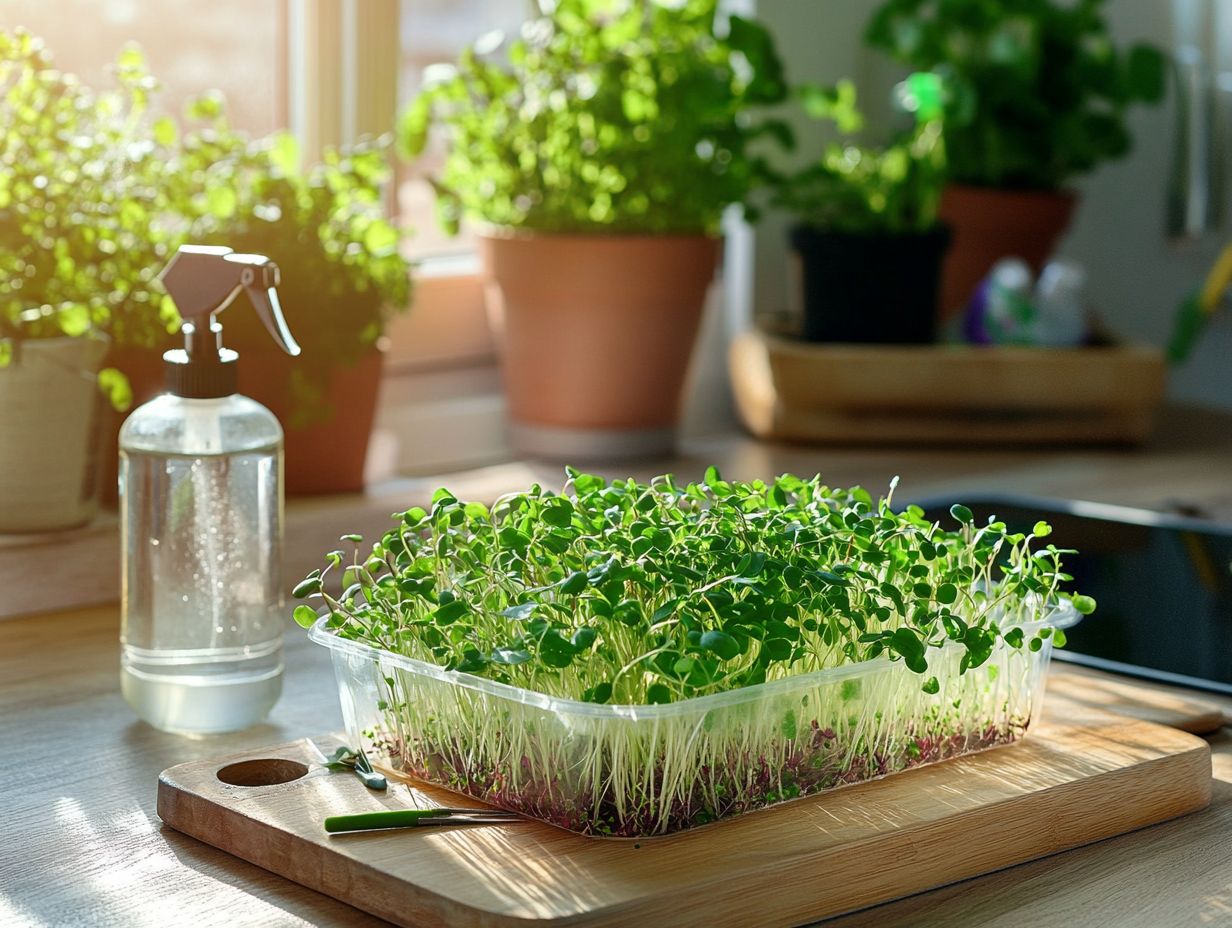
Effective preservation methods are essential for keeping microgreens fresh, greatly extending their shelf life and allowing you to enjoy their benefits longer.
One effective technique is bottom watering. By supplying water from the bottom instead of directly on top, you maintain optimal moisture levels without saturating the greens. This helps prevent rot and other moisture-related issues.
Microgreens are sensitive to ethylene gas, a gas from ripe fruits that can spoil them. To minimize its effects during storage, keep your microgreens away from high ethylene producers like bananas and avocados.
Using breathable storage containers also helps reduce exposure to this gas, ensuring your microgreens stay fresh and vibrant for as long as possible.
Tips for Maintaining Freshness and Quality
To keep microgreens fresh and maintain their quality, implement effective tips and best practices that enhance both shelf life and nutrient retention.
This approach ensures you enjoy an optimal consumption experience every time.
Best Practices for Storing and Handling Microgreens
Following best practices for storing and handling microgreens is essential for preserving their quality and ensuring they deliver maximum nutritional value.
Use a sharp knife when cutting microgreens. This minimizes damage to the delicate stems and leaves, allowing them to maintain their integrity. The moisture balance during storage is also paramount. For instance, varieties like basil and arugula prefer slightly humid conditions, while mustard greens thrive in a drier environment. If you’re interested in expanding your growing techniques, check out this guide on how to grow microgreens in shelves.
To keep nutrients intact, store microgreens in breathable containers with a paper towel to absorb excess moisture, ensuring they remain fresh and vibrant. Regularly check their condition to extend their shelf life, allowing you to savor their unique flavors and health benefits in your culinary creations. For more advanced techniques, learn how to maximize yields from microgreens.
Common Mistakes to Avoid
Avoiding common mistakes in the storage and handling of microgreens is essential for maximizing their freshness and preventing unnecessary waste. This can significantly reduce their nutritional benefits.
Paying attention to factors like moisture balance, airflow, and the right storage containers is key. It’s easy to underestimate how varying humidity levels can lead to wilting or premature decay, especially if microgreens are stacked too closely or confined in airtight bins. Additionally, exploring ways to enhance flavor in microgreens can further improve your growing experience.
To tackle these issues, consider using breathable bags or containers that allow for air circulation while keeping moisture levels in check. The size and material of your storage vessels can also play a crucial role in extending their longevity.
Use these simple tips to enjoy fresh-tasting microgreens packed with nutrients!
Frequently Asked Questions
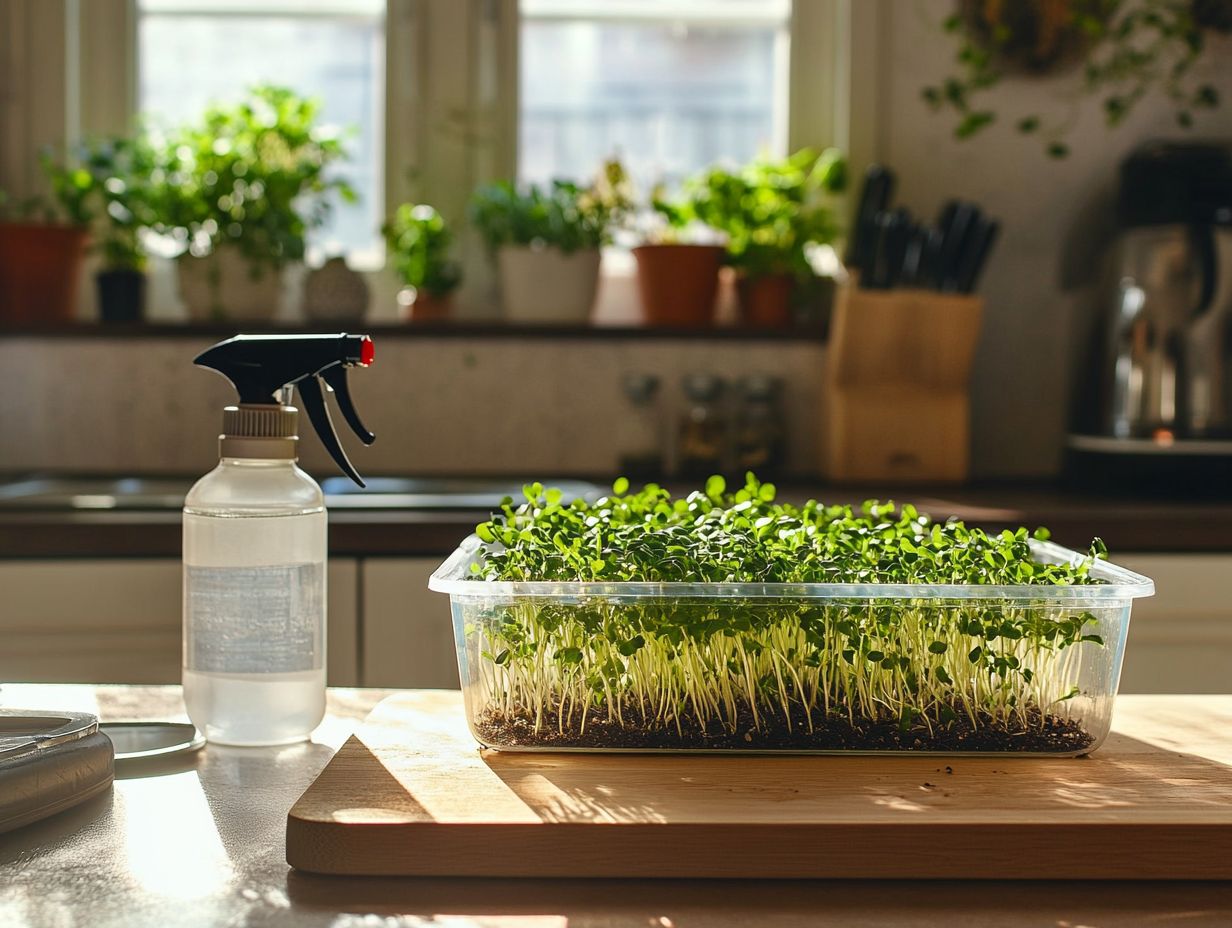
What are microgreens, such as broccoli, cabbage, kale, and radishes, and why is it important to extend their shelf life?
Microgreens are young vegetable greens harvested within 7-14 days of sprouting. They’re nutritious and add great flavor and texture to meals.
It is crucial to extend their shelf life because they are delicate and can spoil quickly, leading to food waste and reducing their nutritional value.
How can I store microgreens to extend their shelf life?
Store microgreens in an airtight container or ziplock bag with a paper towel to soak up moisture. Remove any wilted leaves and keep them in the fridge’s crisper drawer.
How long do microgreens typically last in the refrigerator?
Microgreens typically last 5-7 days in the fridge. Check for wilting or discoloration before eating.
Can I freeze microgreens to extend their shelf life?
Freezing microgreens isn’t recommended because it can ruin their texture and taste. Enjoy them fresh instead!
Are there any tricks to extend the shelf life of microgreens?
Add a paper towel or a few grains of rice to your container to absorb moisture. Lightly mist them before covering them with a damp paper towel.
What are some signs that microgreens have gone bad?
Look for wilting, sliminess, or bad smells. If you notice any of these, it’s best to throw them away.

